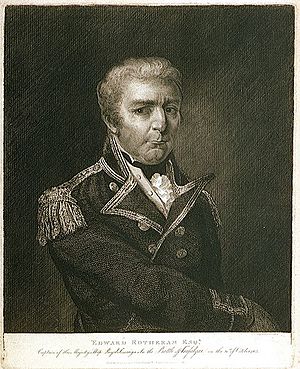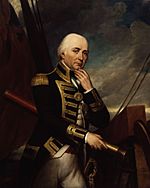Edward Rotheram facts for kids
Quick facts for kids
Edward Rotheram
|
|
|---|---|

Edward Rotheram in 1803
|
|
| Born | 27 December 1753 Hexham, Northumberland |
| Died | 6 November 1830 Bildeston, Suffolk |
| Allegiance | |
| Service/ |
|
| Years of service | 1777 to 1808 |
| Rank | Royal Navy Captain |
| Battles/wars | American Revolutionary War • Battle of Martinique • Battle of St Kitts • Battle of Chesapeake • Battle of the Saintes French Revolutionary Wars • Glorious First of June Napoleonic Wars • Battle of Trafalgar |
| Awards | Companion of the Order of the Bath |
Captain Edward Rotheram (born December 27, 1753 – died November 6, 1830) was an important officer in the British Royal Navy. He served for many years during major conflicts like the American Revolutionary War, the French Revolutionary Wars, and the Napoleonic Wars.
Rotheram took part in several big naval battles. He was a lieutenant at the Glorious First of June in 1794. Later, he was captain of HMS Royal Sovereign at the famous Battle of Trafalgar in 1805. He was praised for his bravery in these battles.
However, Rotheram was known for being a difficult person to work with. His fellow officers and sailors often found him hard to get along with. This eventually led to him leaving active service in 1808. He spent the rest of his life asking the Admiralty for more work and recognition.
Contents
Edward Rotheram was born in 1753 in Hexham, Northumberland. His father, John Rotheram, was a local doctor. Edward was the second of seven children.
When Edward was seven, his family moved to Newcastle-Upon-Tyne. He went to school there with his brothers. His older brother, John, later became a science professor at St Andrew's University.
Edward started working at sea when he was young. He first joined a ship that carried coal from Newcastle. He worked on merchant ships for several years. In 1777, he joined the Royal Navy as a midshipman. This was during the American Revolutionary War. A midshipman was a junior officer in training.
Serving in the American War
Rotheram first served on HMS Centaur. In 1780, he moved to HMS Barfleur. Soon after, he joined HMS Monarch as a lieutenant. He served under a famous commander, Lord Howe.
Monarch was very active in the West Indies during the war. Rotheram fought in several battles there. These included the Battle of Martinique in 1780. He also saw action at the Battle of the Chesapeake in 1781. Then came the Battle of St Kitts and the Battle of the Saintes in 1782. When the war ended in 1783, Rotheram returned to Britain. He was a reserve officer, meaning he was on standby with half his usual pay.
Lieutenant and Commander Roles
In 1785, Rotheram married Dorothy Harle in Newcastle. They had three daughters. He returned to naval service in 1787. He served on HMS Bombay Castle. Over the next four years, he moved between HMS Culloden and HMS Vengeance. All these ships were part of the Channel Fleet.
In 1792, Rotheram became the first lieutenant of HMS Culloden. This meant he was the most senior lieutenant on the ship. He was still in this role when the French Revolutionary War began a year later. Culloden was part of the Channel Fleet under Lord Howe.
Heroic Actions at Sea
The ship's captain was Isaac Schomberg. In May 1794, Lord Howe chased a French fleet far into the Atlantic. This led to a big battle called the Glorious First of June. Culloden was not heavily involved at the start of the battle. Captain Schomberg was later criticized for this.
However, Rotheram became famous after the battle. He organized rescue boats from Culloden and other ships. They saved hundreds of French sailors from the sinking ship Vengeur du Peuple. For his brave actions, Rotheram was promoted to commander on July 6, 1794. He was given command of the supply ship HMS Camel in the Mediterranean.
In 1797, Rotheram moved to the small warship HMS Hawke. He commanded it in the West Indies until 1800. He returned to Britain in 1800 on HMS Lapwing. There, he was promoted to post captain. This was a significant promotion, making him a full captain.
Rotheram commanded Lapwing for the next two years. He worked with the Channel Fleet. He captured several small French ships, which were called "prizes." In 1802, Rotheram went back to reserve duty during a peaceful time called the Peace of Amiens.
Return to Service and Challenges
This break from service lasted until 1804. Rotheram was called back to duty as flag captain of HMS Dreadnought. This was a large warship that carried the flag of Vice-Admiral Cuthbert Collingwood.
Collingwood and Rotheram did not get along well. Collingwood even wrote that Rotheram was "a man of no talent as a sea officer." Despite this, Collingwood chose Rotheram to join him. In October 1805, Collingwood moved to HMS Royal Sovereign. He was the second-in-command of the fleet under Lord Nelson. This fleet was blocking the French and Spanish ships in Cadiz. Nelson knew about the problems between Collingwood and Rotheram. He invited them both to dinner to try and help them get along better.
The Battle of Trafalgar
At the Battle of Trafalgar on October 21, 1805, Royal Sovereign was the first ship in Collingwood's group to break through the enemy lines. Collingwood and Rotheram seemed to work well together during the battle. Collingwood even called out to his captain, "Rotheram, what would Nelson give to be here!" Nelson's HMS Victory was still a few minutes behind Royal Sovereign in reaching the enemy.
Rotheram was also noticed for refusing to take off his full dress uniform and large hat. This clothing was not practical in a battle. It also made him an easy target for enemy snipers.
Royal Sovereign's Fierce Fight
Royal Sovereign's main opponent was the huge Spanish ship Santa Ana. Royal Sovereign fought this ship alone for several minutes at the start. At one point, Royal Sovereign was fighting five different enemy ships. The ship suffered heavy damage and many casualties.
After several hours, Royal Sovereign finally defeated the 112-gun Santa Ana. Both ships were badly damaged and could not be controlled. Royal Sovereign had to be towed by HMS Euryalus. Collingwood moved his flag to Euryalus. Royal Sovereign had nearly 150 casualties, while Santa Ana had over 300.
Santa Ana was later left by her captors and returned to Spanish control. But Royal Sovereign safely reached Gibraltar soon after the battle.
After the Battle
After the battle, Rotheram left Royal Sovereign. He took command of HMS Bellerophon. Its captain, John Cooke, had been killed by a French sniper. Cooke had also been targeted because of his dress uniform.
Bellerophon escorted Victory, which carried Nelson's body, back to Britain. Rotheram carried a special flag behind Nelson's coffin at his funeral in London. Rotheram received a gold medal and a special sword for his service in the battle. He continued to command Bellerophon.
Retirement and Later Life
Rotheram remained in command of Bellerophon in the English Channel and the North Sea. This lasted until 1808. At that time, he faced a formal investigation and was disciplined. This was for unacceptable behavior towards his ship's junior officers and chaplain.
Rotheram stayed in the navy, but he never served at sea again. Collingwood wrote to his sister that he hoped Rotheram could have continued in the navy, even though he thought Rotheram was "a stupid man."
Even though his active career was over, Rotheram kept asking the Admiralty for more sea service and honors. His requests became more angry and demanding. In 1815, many senior naval officers received special honors. Rotheram was only made a Companion of the Order of the Bath. This was a step below a knighthood.
He retired to Bildeston in Suffolk. From there, he continued to ask for new appointments. Finally, in 1828, he was made one of the captains of the Greenwich Naval Hospital.
Rotheram died in Bildeston in 1830. He was buried in the churchyard of St Mary Magdalene. His grave and a memorial plaque can still be seen today. Rotheram never received any more honors or promotions to admiral. He had lost his chance for promotion after the investigation in 1808.
Images for kids




